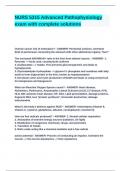NURS 5315 Advanced Pathophysiology
exam with complete solutions
Ovarian cancer site of metastasis? - ANSWER- Peritoneal surfaces, omentum
(fold of peritoneum connecting the stomach with other abdominal organs), *liver*
The increased NADH/NAD+ ratio in the liver from ethanol causes: - ANSWER- 1.
Pyruvate --> lactic acid, causing lactic acidosis
2. Oxaloacetate --> malate. This prevents gluconeogenesis and leads to
hypoglycemia
3. Glyceraldehyde-3-phosphate --> glycerol 3- phosphate and combines with fatty
acids to form triglycerides in the liver, known as hepatosteatosis
4. Decreases citric acid cycle production of NADH and leads to using Acetyl-CoA
for ketogenesis and lipogenesis
What can Reactive Oxygen Species cause? - ANSWER- Heart disease,
Alzheimers, Parkinsons, Amyotrophic Lateral Sclerosis (ALS), CV disease, HTN,
HLD, DM, ischemic heart disease, HF, OSA. Lipid perioxidation, damage proteins,
fragment DNA, less *protein synthesis*, chromatin destruction, damage
mitochondria
What is the body's defense against ROS? - ANSWER- Antioxidants (Vitamin E,
Vitamin C, cysteine, glutathione, albumin, ceruloplasmin, transferrin)
How are free radicals produced? - ANSWER- 1. Normal cellular respiration
2. Absorption of extreme energy sources (radiation, UV light)
3. Metabolism of exogenous chemicals, drugs, and pesticides
4. Transition of metals
5. Nitric oxide acting like a chemical mediator and a free radical
action potential - ANSWER- Process of conducting an impulse. Activates the
neuron --> the neuron depolarizes --> then repolarizes
, Threshold potential - ANSWER- Point at which depolarization must reach in order
to initiate an action potential
Hypokalemia and action potentials - ANSWER- HYPERpolarized (more negative,
ex. -100). Less excitable. Decreased neuromuscular excitability: weakness,
smooth muscle atony, paresthesia, cardiac dysrhythmias
Hyperkalemia and action potentials - ANSWER- HYPOpolarized (more positive,
ex: closer to 0). More excitable. Peaked T waves.
When resting membrane potential=threshold potential, it is BAD = cardiac
standstill, paresthesia, paralysis
Hypocalcemia and action potentials - ANSWER- Increased permeability to Na+.
More excitable. Tetany, hyperreflexia, circumoral paresthesia, seizures,
dysrhythmias.
Hypercalcemia and action potentials - ANSWER- Decreased permeability to Na+.
Less excitable. Weakness, hyporeflexia, fatigue, lethargy, confusion,
encephalopathy, depressed T waves
Atrophy - ANSWER- Occurs as a result of decrease in work load, pressure, use,
blood supply, nutrition, hormonal stimulation, or nervous stimulation. Once the
cell has decreased in size, it has now compensated for decreased blood supply,
nerve supply, nutrient supply, hormonal supply, and has achieved new
homeostasis. Cells are alive but have diminished function and may lead to
cellular death.
Atrophy examples - ANSWER- Physiologic atrophy- shrinking of the thymus
gland during childhood.
Disuse atrophy- someone that ends up being paralyzed
Hypertrophy - ANSWER- Increase in SIZE of cells, which will lead to increase in
size of organ. Caused by hormonal stimulation or increased functional demand.
Hypertrophy examples - ANSWER- physiologic hypertrophy- skeletal hypertrophy
when a person does heavy work or weight lifting / when a kidney is surgically
removed, the other kidney increases in size
pathologic hypertrophy- cardiomegaly results from an increased workload in
hypertensive patients / *left ventricular hypertrophy*




